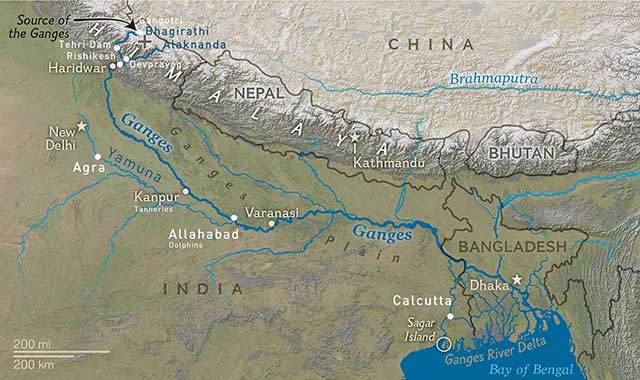
> Portfolio > The Ganges
The secrets of a River
Hindus consider the Ganges River as their Mother (Ma-Ganga) who is able to heal them and free them from the cycle of reincarnation. In the meanwhile the river is feeding several hundred million people and support agriculture and industry.
The sacred river flows over more than 1550 miles (2500 km) from the Gangotri glacier in the Himalayas, where an ashram has been built, as far as the Bay of Bengal, and on its way enriches itself with oxygen (it holds the record of dissolved oxygen) and therefore regenerate itself. Scientists have yet not explained the phenomenon and call it the "X Factor". Besides this, its water used to heal (not anymore) since it is rich in bacteriophages, which kill bacteria. By drinking the holy water one could thus get rid of some bacterial infections. A magic river in some way, but so badly treated that nowadays it is the World most polluted one (by faeces and heavy metals). His exceptional abilities are undermined. Today, the river is sick and needs help.
In 2014, Narendra Modi became the new Indian Prime Minister and he understood the problem. He launched a major rescue program for the Ganges (construction of wastewater treatment centers, closures of polluting enterprises, public awareness ...) but its effects are not yet visible. It will take 10-15 years according to the Minister of the Environment, who has also to fight corruption. In Kanpur, the country’s leather production center, hundreds of tanneries continue to illegally dump heavy metals and chromium into the Ganges. Despite the government shutting some down, the inhabitants still don’t bathe in it.
To treat the Ganges, it is also necessary to look after its major tributary, the Yamuna, which is the only river in the world without dissolved oxygen in the water (measured near the Taj Mahal in Agra). A dead river that miraculously recharges when meeting the Ganges between Kanpur and Varanasi.
Another crucial issue is the excessive use of water by the 200 million farmers in the Ganges basin. Indeed, wild pumping in the groundwater table, massive crops irrigation and water diversions from canals lead to serious problems for the population and its water need. For decades associations have been educating farmers to use water more efficiently (irrigation in small plots vs. the entire field) but it is not enough to change the habits. The only solution would be to ask the farmers to pay for the water they use, which is unlikely to happen in India.
Hope is still permitted since the number of Susus - the famous blind dolphin of the Ganges, almost extinct - is again increasing and some weeks ago an Indian judicial Court granted for the first time the same legal rights as human beings to the Ganges and the Yamuna. Unfortunately, on 7th July 2017 the Supreme Court of India stayed the judgement after only 4 months but it could be inspiring for the younger generations.

The Ganges River is 1550 miles (2500 km) long and flows from the Indian Himalayas through India and Bangladesh, and discharges into the Bay of Bengal.
GEO Germany
Publication in Nov 2019
GEO France
Publication in June 2018
BONUS (in French)
-
Interviews & photos on GEO
- Interview on France Info